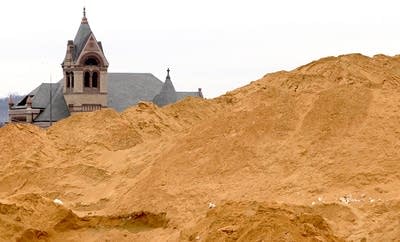Silica sand mine study requested by state agencies

Two state agencies are calling for a broader and more detailed environmental study on two proposed silica sand mines in Winona County.
The recommendation comes as some legislators are considering the possibility of a statewide study of the potential environmental and health effects of the booming industry.
Two Winona County landowners are applying for permits to mine silica sand. While silica sand is used in many industrial applications, demand has recently skyrocketed because it is essential in the process of hydraulic fracturing, or "fracking," that produces oil and gas.
Both of the proposed mines would be operated by Minnesota Sand, a company closely related to several other firms that are planning other mines and a processing facility in the area. The Winona County Board is expected to decide in early March whether to require further study.
Create a More Connected Minnesota
MPR News is your trusted resource for the news you need. With your support, MPR News brings accessible, courageous journalism and authentic conversation to everyone - free of paywalls and barriers. Your gift makes a difference.
That proliferation of mines raises a red flag for both the Minnesota Pollution Control Agency and the Minnesota Department of Health. Both agencies told Winona County's planning and environmental services department that they think the county's brief environmental review, called an Environmental Assessment Worksheet, or EAW, is not enough to fully assess possible impacts.
MPCA Commissioner John Linc Stine said the mines, together with the processing facility, are connected actions that automatically require a bigger study, called an Environmental Impact Statement.
"We believe that meets the definition for connected, phased actions, and that it would be prudent to just do an EIS on the whole thing so the total scope of that mining activity, processing activity and hauling activity can be reviewed at once," Stine said.

The MPCA and the Health Department said the existing study does not provide enough information about how much dust the mines would create, how the mines would protect workers and nearby sensitive populations from possible health impacts from silica dust, and whether pollutants might seep into groundwater and drinking water aquifers in the porous soils of the region.
Silica sand mining is also a hot topic at the Legislature this year. Gov. Mark Dayton has indicated he wants to address the questions it raises. Some legislators are considering bills that would require the state to conduct a generic environmental impact statement on the entire industry, with or without a moratorium on new projects.
Republican Rep. Steve Drazkowski of Mazeppa represents parts of several counties in the region. He said he is not familiar with the details of these projects, but he attended a meeting last week in which he said the governor and commissioners promised not to try to shut down the industry.
"I'm actually very surprised if indeed they're going to put forward an EIS, which is a huge undertaking and expense which can cripple the ability of these projects to move forward," Drazkowski said.
He said local governments have imposed moratoriums and used that time to create effective rules to deal with an industry that is moving on a scale they haven't confronted before.
Drazkowski also said the industry and government should work together to design best management practices for the mines.
The Senate Environment Committee will take up proposed legislation later this month.

